Related Research Articles
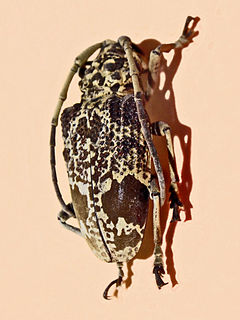
Phryneta is a genus of flat-faced longhorn beetles belonging to the family Cerambycidae.

Phrynetini is a tribe of longhorn beetles of the subfamily Lamiinae. It was described by Thomson in 1864.
Phryneta asmarensis is a species of beetle in the family Cerambycidae. It was described by Stephan von Breuning in 1969. It is known from Eritrea.
Phryneta hecphora is a species of beetle in the family Cerambycidae. It was described by James Thomson in 1857. It is known from Mozambique and Democratic Republic of the Congo.

The Castilloa Borer is a species of beetle in the family Cerambycidae. It was described by Johan Christian Fabricius in 1775, originally under the genus Lamia. It has a wide distribution throughout Africa. It feeds on Morus alba, Hevea brasiliensis, Coffea arabica, and Chlorophora excelsa.

Phryneta macularis is a species of beetle in the family Cerambycidae. It was described by Harold in 1879. It is known from the Democratic Republic of the Congo and Angola.
Phryneta atricornis is a species of beetle in the family Cerambycidae. It was described by Léon Fairmaire in 1893. It is known from Comoros.

Phryneta aurocincta is a species of beetle in the family Cerambycidae. It was described by Félix Édouard Guérin-Méneville in 1832, originally under the genus Lamia. It has a wide distribution throughout Africa.
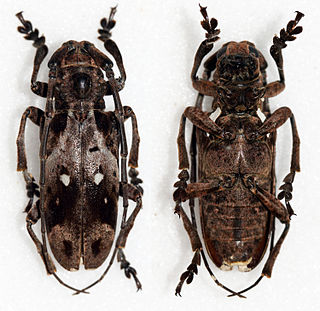
Phryneta bulbifera is a species of beetle in the family Cerambycidae. It was described by Hermann Julius Kolbe in 1894, originally under the genus Phrystola. It is known from the Democratic Republic of the Congo and Cameroon.
Phryneta coeca is a species of beetle in the family Cerambycidae. It was described by Chevrolat in 1857. It is known from Tanzania, the Central African Republic, the Ivory Coast, Cameroon, the Democratic Republic of the Congo, and Togo.
Phryneta conradti is a species of beetle in the family Cerambycidae. It was described by Hermann Julius Kolbe in 1894. It is known from the Democratic Republic of the Congo, Tanzania and Malawi.
Phryneta ellioti is a species of beetle in the family Cerambycidae. It was described by Charles Joseph Gahan in 1909. It is known from Uganda and the Democratic Republic of the Congo.
Phryneta ephippiata is a species of beetle in the family Cerambycidae. It was described by Francis Polkinghorne Pascoe in 1864. It is known from South Africa and Namibia.
Phryneta escalerai is a species of beetle in the family Cerambycidae. It was described by Báguena and Stephan von Breuning in 1958. It is known from Bioko.
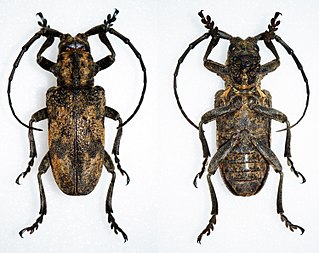
Phryneta obesa is a species of beetle in the family Cerambycidae. It was described by Westwood in 1845. It has a wide distribution in Africa.
Phryneta obliquata is a species of beetle in the family Cerambycidae. It was described by Harold in 1878. It is known from Tanzania, Uganda, Somalia, the Democratic Republic of the Congo, Ethiopia and Kenya.
Phryneta pallida is a species of beetle in the family Cerambycidae. It was described by James Thomson in 1857. It is known from South Africa.
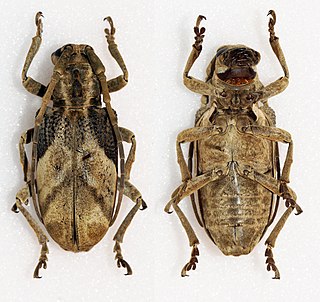
Phryneta semirasa is a species of beetle in the family Cerambycidae. It was described by Dohrn in 1885. It is known from Tanzania, the Democratic Republic of the Congo, Mozambique, Zimbabwe, Malawi, and Zambia.
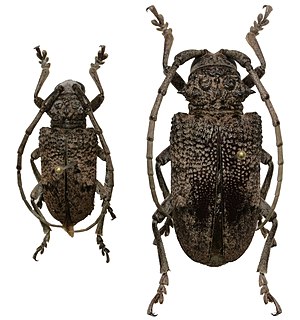
The Fig-tree Borer Longhorn Beetle, or Fig Tree Borer, is a species of beetle in the family Cerambycidae. It was described by Johan Christian Fabricius in 1792, originally under the genus Lamia. It has a wide distribution throughout Africa. It feeds on Pyrus communis, Ficus carica, Salix babylonica, Cupressus sempervirens, and Vitis vinifera.

Phryneta verrucosa is a species of beetle in the family Cerambycidae. It was described by Dru Drury in 1773, originally under the genus Cerambyx. It is known from Equatorial Guinea, and was introduced into Barbados, Grenada, and Trinidad and Tobago.
References
- ↑ "Phryneta luctuosa". lamiinae.org. Retrieved 2021-02-03.
- ↑ BioLib.cz - Phryneta luctuosa. Retrieved on 8 September 2014.